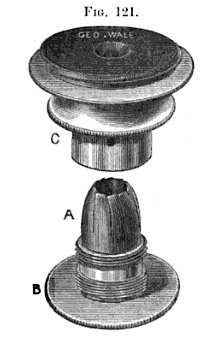

The main focus of this microscope utilizes a fusee chain mechanism. The microscope can be reversed on its base.


Engraved on the inset brass handle of the case is the name of the original owner, C.J. Svehla
George Wale was born in the U.S. in 1840 from parents who emigrated from England. He initially worked with partners. There are known instruments signed "Hawkers & Wale" as well as those signed "Morrison & Wale". By the late 1870's he was working alone.
The following was extracted from: Practical Hints on the Selection and Use of the Microscope, by John Phin, 1877
CONTINENTAL MODEL.
As made by Geo Wale, Paterson. N. J.

The Continental Form. Most of the stands made by the better class of French, German and Austrian microscope makers are characterized by a low, compact form, and great simplicity and solidity of construction. Our engraving, Plate I, shows a very serviceable instrument, manufactured by Mr. George Wale, formerly of the Stevens' Institute, now of Paterson, New Jersey. The general form of this stand is very similar to that of the large model of Nachet, of Paris, but the details of construction have been changed considerably, and we think for the better in many respects. The coarse movement is effected by means of a pinion and chain, the latter being kept tight by means of a spring instead of by a screw, as is the common method, and as the pinion round which the chain is wound is milled so that the links fit into it, all slip is avoided, and there is positively no "lost motion" whatever the movement responding promptly in either direction even when suddenly reversed. The fine movement consists of a lever which carries the entire body (coarse movement included) downward by means of a spring, and upward by means of a screw, the milled head of which is placed below the arm which carries the body. This brings both movements so close together that the hand may be kept on both at the same time the thumb and fore finger operating the coarse movement, while the third and fourth fingers make the fine adjustment.
A peculiarity of this microscope is found in the method by which the pillars which support the arm are attached to the foot. Instead of being screwed directly to the foot or cast on it, as is sometimes the case, they are screwed to a circular plate which rotates with a smooth and firm motion. This enables the microscopist to plane the horse-shoe either behind the stage, when the instrument is used in a horizontal or greatly inclined position (as shown in the engraving), or in front of it when used in a vertical position. This confers great steadiness, with a comparatively light and convenient base.
As our purpose is not to give a minute description of any of these stands, but merely to call attention to their characteristic features, we omit all mention of the very ingenious devices which Mr. Wale has introduced into its construction, such as his new form of iris diaphragm, etc.
The advantages of this general form of stand are, that it is low and compact, so that it can be easily used in a vertical position a favorite method with physicians and histologists. And so generally has it become a favorite, that most of our best makers have found themselves compelled to furnish microscopes of this model in order to retain their customers. Grunow, McAllister, Zentmayer, and others in this country, and even such English makers as Beck, Crouch, etc., have recently begun to manufacture microscopes of the Continental model in addition to their other styles.
The novel iris diaphragm on this microscope is covered in the June 6, 1876 patent granted to Wale.
Iris Diaphragms.To the " Working Microscope " of G. Wale an inexpensive and very simple and ingenious form of " iris" is adapted, shown (separated) in Fig. 121. It consists of a piece of very thin cylindrical tube A, about 3/4 inch in length and 2 in. diameter, the whole circumference of which is cut through with shears to nearly its whole length at intervals of about 1/4 inch ; by means of a screw-collar B, attached below, this cut tube is forced into a parabolic metal shell (contained within C) whose apex is truncated to an aperture of about 3/8 inch ; the pressure of the screw causes the thin metal tongues to turn and to overlap in a spiral which gradually diminishes the aperture to the size of a pin-hole. On unscrewing the collar B, the spiral overlapping of the tongues is released somewhat, and their elasticity causes the aperture gradually to expand. As adapted to the stage of the " Working Microscope," the iris, when unscrewed until its aperture is smallest, is then almost in contact with the base of the slide ; when at its largest expansion it is about 1/16 inch lower. The whole device is fitted into the opening of the stage from beneath (so as to be flush with the upper surface) with one turn of a very coarse screw on the edge of C, a far more convenient plan than the " bayonet joint."



